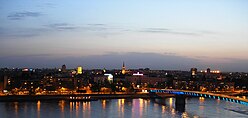
Back Novi Sad Afrikaans نوفي ساد Arabic نوفى ساد ARZ Novi Sad AST Нови-Сад Bashkir Нові-Сад Byelorussian Новы Сад BE-X-OLD Нови Сад Bulgarian Novi Sad BJN নোভি সাদ Bengali/Bangla
Novi Sad
Нови Сад (Serbian) | |
|---|---|
| Град Нови Сад Grad Novi Sad City of Novi Sad | |
Panorama of Novi Sad Freedom Square | |
|
| |
| Nickname: Serbian Athens | |
| Coordinates: 45°15′15″N 19°50′33″E / 45.25417°N 19.84250°E | |
| Country | |
| Province | |
| District | South Bačka |
| Settled by Scordisci | 4th century B.C. |
| Founded | 1694 |
| City status | 1 February 1748 |
| Government | |
| • Mayor | Milan Đurić (SNS) |
| • Ruling parties | SNS/SDPS/SPO–SPS/JS–SVM |
| Area | |
| • Urban | 129.4 km2 (50.0 sq mi) |
| • Rank | 36th in Serbia |
| • City proper | 106.2 km2 (41.0 sq mi) |
| Elevation | 80 m (262 ft) |
| Population | |
| • Rank | 2nd in Serbia |
| • Urban | 327,051 |
| • Urban density | 2,500/km2 (6,500/sq mi) |
| • Metro | 414,562 |
| • City proper | 295,555 |
| Demonym(s) | Novosađanin (Новосађанин, m.) Novosađanka (Новосађанка, f.) (sr) |
| Time zone | UTC+01:00 (CET) |
| • Summer (DST) | UTC+02:00 (CEST) |
| Postal code | 21000 |
| Area code | +381(0)21 |
| Vehicle registration | NS |
| Website | www.novisad.rs |
Novi Sad (Serbian Cyrillic: Нови Сад, pronounced [nôʋiː sâːd] ⓘ; see below for other names) is the second largest city in Serbia after the capital Belgrade and the capital of the autonomous province of Vojvodina. It is located in the southern portion of the Pannonian Plain on the border of the Bačka and Syrmia geographical regions. Lying on the banks of the Danube river, the city faces the northern slopes of Fruška Gora and it is the fifth largest of all cities on the Danube river. It is the largest Danube city that is not the capital of an independent state.
According to the 2022 census[update], the population of the city proper area totals 295,555 [3] while its urban area (including the adjacent settlements of Petrovaradin and Sremska Kamenica) comprises 327,051 inhabitants. According to the city's Informatika Agency, Novi Sad had 414,562 inhabitants (metro area) in 2025.[citation needed]
Novi Sad was founded in 1694, when Serb merchants formed a colony across the Danube from the Petrovaradin Fortress, a strategic Habsburg military post. In subsequent centuries, it became an important trading, manufacturing and cultural centre, and has historically been dubbed the Serbian Athens.[4][5] The city was heavily devastated in the 1848 Revolution, but was subsequently rebuilt and restored. Today, along with the Serbian capital city of Belgrade, Novi Sad is an industrial and financial center important to the Serbian economy.
Novi Sad was the European Youth Capital in 2019 and the European Capital of Culture in 2022.[6] It became a UNESCO Creative City of Media Arts in 2023.[7][8]
- ^ Serbian census 2022
- ^ "First results of the 2022 Census of Population, Households and Dwellings" (PDF). stat.gov.rs (in Serbian). Statistical Office of Serbia. Archived from the original on 21 November 2020. Retrieved 22 December 2022.
- ^ "2022 Census of Population, Households and Dwellings: Ethnicity (data by municipalities and cities)" (PDF). Statistical Office of Republic Of Serbia, Belgrade. April 2023. ISBN 978-86-6161-228-2. Retrieved 30 April 2023.
- ^ Mishkova, Diana (1 January 2009). We, the people: politics of national peculiarity in Southeastern Europe. Central European University Press. pp. 277–278. ISBN 9789639776289.
- ^ "History of Novi Sad". Official Website of Novi Sad. Archived from the original on 19 July 2011.
- ^ "Esch, Kaunas and Novi Sad to be European Capitals of Culture in 2022". European Commission.
- ^ "55 new cities join the UNESCO Creative Cities Network on World Cities Day". www.unesco.org. Retrieved 31 October 2023.
- ^ "Novi Sad u Uneskovoj Mreži kreativnih gradova sveta: "Srpska Atina" prva u ovom delu Evrope na Media Arts listi". euronews.rs (in Serbian). 31 October 2023. Retrieved 31 October 2023.














